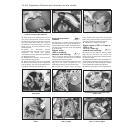
4 Using a ring spanner and an open-ended
spanner, unscrew and remove the caliper
cylinder housing lower guide bolt (photo).
Release the upper bolt, but do not remove it.
5 Swivel the cylinder housing upwards and tie
it up out of the way. There is no need to
disconnect the hydraulic hose. The sensor
wiring plug will have to be disconnected
(where fitted).
6 Remove the pads, complete with anti-rattle
springs (photo).
7 Clean away all dust and dirt, taking care not
to inhale it as it may be injurious to health.
8 The caliper piston must now be fully
depressed to accommodate the new, thicker,
pads. Do this using a G-clamp or lever, but
anticipate a rise in the brake fluid reservoir
level by syphoning out some of the fluid using
a clean syringe.
9 Fit the new pads, which must be of the
same type as the originals, complete with
anti-rattle springs.
10 Locate the cylinder body. The fixing bolts
are of self-locking type, and should be
renewed whenever they are loosened or
removed. If new ones are not available, clean
the threads of the old ones thoroughly and
apply thread-locking fluid (photo). Tighten the
bolts to the specified torque. Check that the
rubber dust excluders are in good condition.
11 Reconnect the sensor wiring plug.
12 Renew the pads on the other front wheel.
13 Refit the roadwheels, and then apply the
footbrake several times to position the pads
against the discs.
14 Top up the brake fluid reservoir if
necessary (photo).
Front disc caliper -
removal and refitting #
15 Raise the front of the car and remove the
appropriate roadwheel.
16 Using a ring spanner and an open-ended
spanner, unscrew and remove the cylinder
housing fixing bolts.
17 Withdraw the cylinder housing, and then,
holding it firmly, release the flexible hydraulic
hose union. Unscrew the cylinder body from
the end of the flexible hose, and then cap the
end of the hose to prevent loss of fluid.
18 If required, the disc pads can be removed
and the caliper support bracket unbolted and
removed.
19 Refitting is a reversal of removal, but use
new fixing bolts.
20 Bleed the front hydraulic circuit.
Front disc caliper - overhaul
21 The operations are as described in
Chapter 8, Section 5, paragraphs 6 to 13.
Front brake disc - inspection,
renovation or renewal
22 The operations are as described in
Chapter 8, Section 6, but the caliper fixing
bolts are secured with thread-locking fluid;
lockplates are not used.
Rear disc pads - renewal ™
23 Any wear in the disc pads can be
observed through the aperture in the caliper
cylinder body, once the car has been jacked
up and the roadwheels removed (photo).
24 If the thickness of the pad friction material
is less than 1.5 mm, renew the pads on both
sides in the following way.
25 Using a ring spanner and an open-ended
spanner, unscrew the caliper cylinder body
fixing bolts.
26 Withdraw the caliper and remove the disc
pads, complete with anti-rattle springs (photo).
27 Clean away all dust and dirt, but avoid
inhaling it, as it may be injurious to health.
28 Fully retract the caliper piston in order to
accommodate the new, thicker, pads. To do
this, rotate the piston clockwise, using a
suitable tool engaged in the handbrake
sectors (photo). Anticipate a rise in the brake
fluid reservoir level by syphoning out some
fluid, using a clean syringe.
Supplement: Revisions and information on later models 13•101
14B.10 Applying thread-locking fluid to the
bolt threads
14B.6 Disc pad and anti-rattle spring
removal
14B.4 Unscrewing the caliper cylinder
housing lower guide bolt
14B.28 Rotating a rear caliper piston14B.26 Withdrawing the rear brake caliper14B.23 Rear brake pad inspection aperture
14B.14 Topping up the brake fluid reservoir
(1301 cc Turbo ie model)
13


















